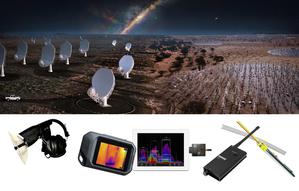Glossary term: Radio Astronomy
Description: Radio astronomy is the branch of astronomy concerned with observations of radio waves, a special region in the electromagnetic spectrum. Earth's atmosphere has "radio windows": It allows radio waves in certain frequency (or wavelength) ranges to pass nearly unhindered. That fact allows for observations of such radio waves from astronomical objects with ground-based radio telescopes. Typical observing frequencies range from an upper limit of about 300 gigahertz (GHz) down to tens of megahertz (MHz). This corresponds to wavelengths of 1 millimeter (mm) to tens of meters, respectively. By going to particularly suitable dry, high-altitude locations, astronomers can even perform submillimeter observations, down to wavelengths of about 0.3 mm, corresponding to frequencies of up to 1 terahertz (THz). The lower frequency limit at about 10 MHz is due to Earth's so-called ionosphere. That high-altitude region within our atmosphere contains numerous charged particles, which reflect ultra-long radio waves right back into space. Radio astronomy enables us to observe the emission from cold gas in galaxies and the Milky Way, such as atomic hydrogen and molecular gas. In this way, astronomers can study the diffuse interstellar medium, as well as the regions and processes in which stars and planets are born. Radio astronomy also allows for the study of highly energetic objects such as pulsars and active galactic nuclei: In or around objects like those, electrons are accelerated in a strong magnetic field, leading to the emission of radio waves known as synchrotron radiation. Pulsars and the very bright active galactic nuclei known as quasars were discovered using radio astronomy, as was the remnant of our Universe's hot Big Bang phase, the cosmic microwave background (CMB). Although radio waves from space were first detected in the 1930s, radio astronomy only became a major branch of observational astronomy after 1950.
Related Terms:
See this term in other languages
Term and definition status: This term and its definition have been approved by a research astronomer and a teacher
The OAE Multilingual Glossary is a project of the IAU Office of Astronomy for Education (OAE) in collaboration with the IAU Office of Astronomy Outreach (OAO). The terms and definitions were chosen, written and reviewed by a collective effort from the OAE, the OAE Centers and Nodes, the OAE National Astronomy Education Coordinators (NAECs) and other volunteers. You can find a full list of credits here. All glossary terms and their definitions are released under a Creative Commons CC BY-4.0 license and should be credited to "IAU OAE".
If you notice a factual error in this glossary definition then please get in touch.
Related Media
Parkes Radio Telescope
Credit: David McClenaghan/CSIRO credit link
License: CC-BY-3.0 Creative Commons Attribution 3.0 Unported icons
Related Activities
SKAO and the mysteries of invisible light
astroEDU educational activity (links to astroEDU website) Description: Discover the invisible light with SKAO, the largest radio telescope in the world!
License: CC-BY-4.0 Creative Commons Attribution 4.0 International (CC BY 4.0) icons
Age Ranges:
12-14
, 14-16
Education Level:
Informal
, Middle School
, Secondary
Areas of Learning:
Guided-discovery learning
, Observation based
, Technology-based
Costs:
High Cost
Duration:
several days
Group Size:
Group
Skills:
Asking questions
, Constructing explanations










